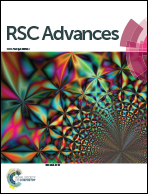New post-processing method of preparing nanofibrous SERS substrates with a high density of silver nanoparticles
Abstract
SERS enabling substrates with increased sensitivity, their manufacturing reproducibility and enhanced structural stability are highly demanded in SERS applications. Therefore our main aim was to elaborate a simple and inexpensive method of functionalization of electrospun chitosan nanofibers by using silver nanoparticles (AgNP). For that purpose we established a protocol where we were able to control the density of AgNP on the surfaces of nanofibers, and thus electromagnetic hotspots, simply by variation of Tollens' reagent. By webbing of such fibers we were able to prepare films that were enabling SERS either of solutes or macromolecular structures such as bacterial cells. Especially, to detect bacterial cells we established two approaches of immobilisation of cells within the films, which enabled their detection with enhancement of sensitivity by a factor of 105 and an average of 25% spot-to-spot variation.

- This article is part of the themed collection: Editors' collection: Physical Chemistry of Colloids and Interfaces

 Please wait while we load your content...
Please wait while we load your content...